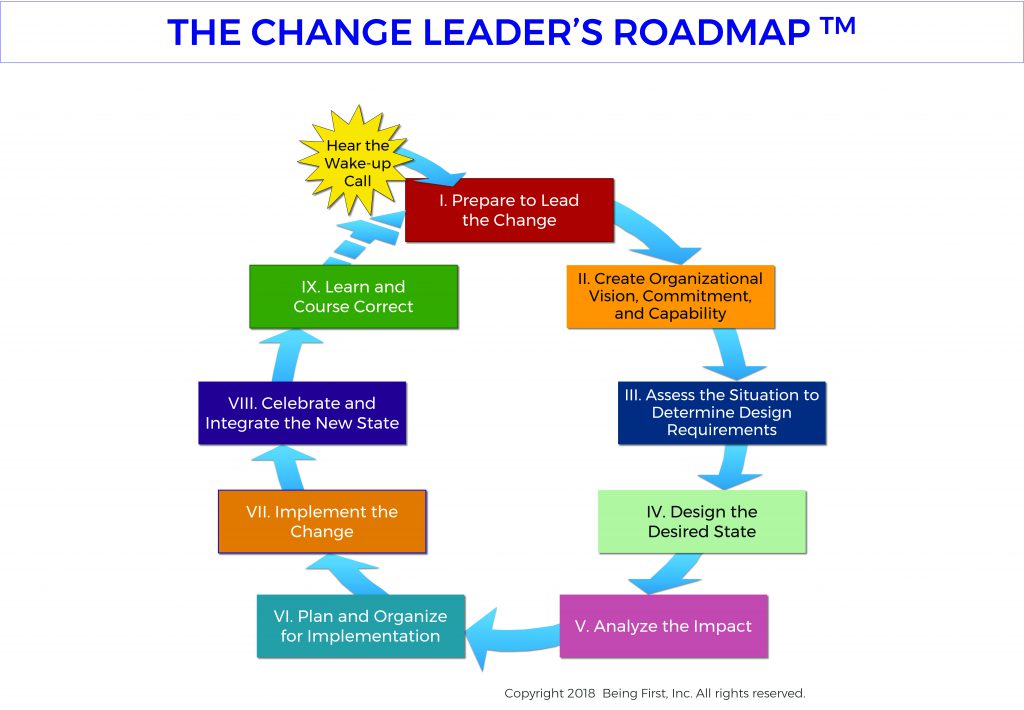Overview
This article is about leadership — self-leadership, the leadership of organizations, and the leadership of social and planetary change. It’s about the type of leadership that can accelerate transformation at all levels of scale — in you, your team, organization, community, and the world. It’s about the leadership that is required in our dynamic 21st-Century reality, one that unites people to common causes, and unleashes their potential to work together to achieve breakthrough outcomes. It’s about the leadership of change that will make your business more successful, whether it be a startup or a 90-year-old conventional organization. And it’s about the leadership that can raise the tide of humanity for the betterment of all. We call this conscious change leadership. Before we describe this leadership capability, let’s look at why it is so critical in today’s world.
Living in a changing world
These are polarizing times, yet one thing most everyone can agree on is that we are living in a VUCA environment: volatile, uncertain, complex, and ambiguous. Our personal and professional lives are more dynamic and complicated than ever. Change and flux are everywhere— in our organizations, family systems, climate, technological advances, healthcare, politics, and education. In every area, the speed of change is increasing. Life is harder to manage and outcomes more difficult to predict.
The good news is that in the middle of this chaos, people and society are slowly but surely changing for the better. Transformational shifts in mindsets, behavior, and culture are occurring in every corner of the planet. Conventional beliefs, behavior, and institutions are shifting. More and more people are living alternative lifestyles. More are eating organically, meditating, and staying fit. Same-sex marriages are proliferating. More people are working from home or starting their own businesses. More are recycling, and in general, social activism is increasing.
Moving beyond convention is also very evident in the types of businesses young entrepreneurs are starting. Many are pushing the envelope of new technologies while also pushing social norms forward. The values in their corporate cultures are more inclusive, cooperative, and caring. There is more respect for individual diversity. Leaders of these organizations display far greater concern for the environment and the impact of their businesses on local communities. They are changing society by creating more positive cultures and work environments and transforming how business — at least in their spheres of influence — is conducted.
Another sign we are approaching a major paradigm shift is the increase in collective awareness of what is broken in the old paradigm. The “Me Too” movement is a great example. The fact that more people now see inappropriate sexual advances and gender discrimination as wrong is a sign of social progress. The same is true of the sexual abuses of children by priests, the violence and racial profiling being exposed in some police forces, and the increasingly overt signs of the negative impacts of pollution on climate. The underlying problems of each have been occurring for decades. Greater public awareness and concern for these issues means we are waking up collectively. Not all of us but many, and more than before.
When social paradigms transform, the early adopters on the cutting-edge forge new territories, while those attached to the “old ways” become threatened by these advancements. They resist the changes, and as progress occurs, they resist even more. People’s actions during major social paradigm shifts depends on their worldview as either creators of change, resistors of change, or fence-sitters waiting to see if any positive change occurs. We are advocates for the creators of change, and work tirelessly to bring along the fence-sitters and create breakthroughs for the resistors. It is the creators of change who bring the conscious awareness that is the fuel for conscious change and human evolution. We need more of us, especially in leadership positions.
The leadership challenge of change
The challenge of leadership is how to mobilize more people to join this wave of human evolution and conscious transformation. Leaders must not only be able to see the transformations needed, but must mobilize people and resources to make them happen, then design and implement the transformational journey so that they actually do. This challenge exists at all levels of leadership. It doesn’t matter if you are a community activist, startup founder, a senior executive in a Fortune 500 company, or a national or world leader, the key to success in our VUCA world is learning how to mobilize and lead transformation.
Building this transformational capability in more leaders is a core strategy for accelerating change in your organization, and in the world.
Conscious change leadership
For 40 years, we have been working with CEOs and their executive teams to transform themselves and their organizations. In all our years of helping leaders and organizations transform, our primary learning is this: the degree to which the organization transforms is in direct proportion to the level of consciousness of the CEO and senior leaders. The more evolved the leaders, the more likely their organization is to succeed at transformation.
A primary way to accelerate social change is to transform leaders by catalyzing breakthroughs in their mindsets and behavior and developing their transformational leadership skills. Most critical is transforming the leaders at the top of organizations, for they hold the power. How they execute that power either supports creating a positive future or inhibits it.
The current and traditional methods of organizational change do not address transforming leaders. Project management, change management, continuous improvement, and organization development, while providing some value to the execution of change, do not address leadership directly. We need an approach to change leadership that does.
Our approach integrates the personal transformation of leaders and the methods and skills of organization transformation. Again, we call this approach conscious change leadership. Each word —conscious, change, and leadership — represents unique developmental targets. Let’s explore them.
Conscious
The conscious aspect of conscious change leadership refers to waking leaders up and helping them transform through increased self-awareness. Conscious means the proactive pursuit of self-development and one’s own self-mastery. It requires teaching the process of personal change and providing the awareness tools and practices that put — and keep — leaders on a path of conscious growth and development.
Transformational leaders must pursue their own self-mastery. They must become more conscious of their mindsets, more awake to how they operate within. Why? Because mindset is causative. Our fundamental assumptions about reality, including our beliefs, values, and world views, determine how we interpret and react to what occurs around us. As Anaïs Nin said, “We don’t see the world as it is; we see the world as we are.” Our interpretation determines the conclusions and decisions we make, as well as our mental, emotional, and physical reactions. These influence our actions and quality of performance, which determines our results.
If mindset doesn’t change to match and generate the future we need, then we recreate the very circumstances that limit that future. Human conditioning has us create our outer world as a reflection of our inner state of mind and way of being. If this occurs unconsciously, we never think about whether our mindset is generating the future we want and need, or inadvertently blocking it. Until we can objectively see how we habitually operate, we cannot make the personal changes required to lead the transformation to a new reality.
There are four levels of capability leaders need to develop to become more conscious and skillful at leading organizational and social transformation.
The first level is self-awareness and mindfulness. This enables leaders to see their mindsets in action, and discover the beliefs and assumptions that previously operated unconsciously within them. They discover their unconscious biases, including their self-limiting mental, emotional, and behavioral patterns and how they impact their perception of reality. They see how their ways of being, working, and relating impact others and influence their performance and results. Without this self-awareness, they will continue to recreate the very circumstances that limit them and their organizations.
The next level of development is self-management and centering. This teaches leaders how to manage their interiors, how to get back to center when stressed, and how to more frequently operate in the “flow” of high performance.
The third level is self-leadership and personal change. Here, leaders learn the process and tools of changing the personal patterns they now see. They learn how to accept and release these negative patterns, and create and embody new, more positive ways of being, working, and relating.
The fourth level is self-mastery and being, where leaders do the deeper work of personal healing and transforming their core limiting beliefs. They acquire more advanced perspectives, access greater intuition, and operate from a deeper sense of presence. These leaders are then capable of seeing solutions and navigating the complexities inherent in their challenges to generate breakthrough solutions.
This four-level development is designed to support “vertical leadership development,” meaning that leaders literally raise their level of consciousness to operate from broader perspectives that are more inclusive and co-creative. Vertical leadership development is cutting-edge executive development. As leaders ascend in their consciousness, they have a broader mindset and the ability to maintain it under stress. They can handle greater complexity and solve bigger challenges. Specifically, they see hidden cause-and-effect relationships among the many variables in their organization’s transformation. They see inter-dependencies others miss, distant and delayed consequences of current local actions, and can sense how people will think and react.
Conventional leaders break problems apart and try to solve things in pieces, but in transformation, when you attempt to optimize the part, you sub-optimize the whole. Conscious leaders become integrators, co-creators, and unifiers. They see how things connect and come together to create greater wholes. This capability makes them uniquely equipped to lead the complexity of organization transformation. Because they are mindful of their interior and know how to manage and change it to operate from higher states of being, they are fundamentally more qualified to succeed in the complex human and social challenges we face.
Change
The change part of conscious change leadership is about teaching leaders how to design and implement transformation, so it engages stakeholder commitment and contribution and delivers sustainable positive results. This starts with understanding that all organizational change is not the same.
There are three different types of change: developmental, transitional, and transformational. Each requires unique leadership strategies, methods, and process plans. Developmental and transitional changes can often succeed using conventional approaches, but not transformation. Transformation requires more advanced methodologies. Conscious leaders — and their consultants — need to understand the differences among the types and the specific requirements of transformation. Simply being in a state of heightened consciousness is not adequate to drive action. They must also master transformational strategies and tools to enact change.
Developmental change is largely improvement of an existing operation or work practice, such as selling more, reducing errors, or using a better widget for a known purpose. It is the simplest form of change and the least disruptive. Developmental change processes are usually handled within the activities of normal operations, supported by communications and training in the new ways.
Transitional change involves the identification of a current-state problem and the determination of a future-state solution. The current state must then be dismantled while the new solution is being put into place. Transitional changes include simple restructuring, expanding into new services or products, or redesigning a business process. Transitional change processes are more complex as people must leave behind the old way of doing things and learn to master the new. These change processes are usually controllable using a pre-determined plan and timeline, and therefore can be led using project management. Change management is often deployed to handle the people requirements of letting go and then adopting the new ways.
By far, the most complex type is transformational change. These are profound paradigm-busting changes in strategy, structure, business systems, or technology. These changes are so significant that they also require transformation in leaders’ and employees’ mindsets and behavior and the organization’s culture for the new reality to succeed. Therefore, transformation requires an “integral” view of reality, where leaders see the inter-dependencies and impacts between the “content” or structural aspects of the transformation and the human requirements of mindset, behavior, and culture change. Seeing this inter-dependency — this larger whole — requires a broader perspective than most leaders have. Hence, the need for developing greater consciousness in leaders.
While transformational change begins with a vision of what’s possible, the actual new state cannot be fully known before the change process begins. Leaders — and the workforce — must forge ahead and work together to figure out the future state as they go. Because the desired solution is not clear at the beginning, the process for getting there cannot be clear either. This requires a different type of navigation system, more strategic and inherently more flexible. We use two strategic navigation systems, one to guide enterprise-level transformation, and one to guide the many critical-change initiatives that comprise that transformation. For transformation at the enterprise level, we use The Breakthrough Process to guide the organization’s overall transformational journey.

Traditional methods like LEAN, Six Sigma, and program/project management do not provide this level of strategic guidance for the whole enterprise. First, they do not adequately develop or integrate leaders’ mindsets, behavior, or culture change. Second, they are too rigid and inflexible, often demanding adherence to being “on time and on budget.” Yet at the beginning of a transformation, you cannot accurately predict time or budget. Leaders must rely on a “rolling, 90- to 120-day planning cycle,” informed by the strategic guidance system of The Breakthrough Process to align around and outline the direction and meta-activities required for success.
This is a freak-out for leaders with conventional mindsets, another of the many reasons leaders must develop their conscious awareness and learn to manage their egos’ needs for control and predictability. Organization transformation is messy, non-linear, and requires ongoing course correction as the new state emerges. At the enterprise level, there are numerous work-streams or initiatives, many of which need to be integrated. There may be teams working on re-structuring, HR systems like talent management, business processes like resource allocation or supply, technology implementations, and of course, culture change. Each of these initiatives needs its own 120-day rolling plan informed by a project-based guidance system. For this, we use The Change Leader’s Roadmap.

The Change Leader’s Roadmap has a 40-year proven record for guiding successful transformational initiatives. It is an operating system for change, guiding leaders and project teams to consciously design and implement their initiatives so they attend to all the organizational and human dynamics (mindset, behavior, and culture) required to succeed. It guides leaders and consultants to ensure adoption through active engagement of the very people who must make the change a reality.
Each strategic navigation system, The Breakthrough Process and The Change Leader’s Roadmap, provides leaders the methodology, tools, and how-to guidance that is commensurate with their more conscious mindset. However, that still requires them to lead in ways that model and mobilize people to co-create their transformational outcomes.
Leadership
Like it or not, command-and-control leadership still permeates many of our organizations. This style treats people as cogs in the machinery of the organization. It limits people’s contribution, innovation, and well-being and therefore does not work in transformation. Leaders must learn and adopt a more “co-creative” leadership style, the third developmental target in developing conscious change leaders.
Co-creating means working in partnership, collaborating and supporting one another toward a common vision or goal. This orientation is required in transformational leaders because it unleashes more of the human potential in the organization to work across hierarchical and functional boundaries to solve big challenges. It is relationship-oriented and models speaking truthfully without judgment, listening to be influenced, and respecting diversity of all types. It means doing what is right, over the ego’s need to be the expert or look good. It virtually erases the chaos of politics.
Co-creating teaches leaders how to turn in to discomfort rather than avoid it, so conflict can be resolved in healthy ways and solutions found. It is a natural way of being when people grow from within, transform self-limiting ego patterns, and become more whole in themselves.
Co-creative change leaders consciously create and model a culture of accountability, authenticity, care, and trust. To align and generate the best from their people, they engage them early and often in business-critical decisions and needs. They work across boundaries for increased innovation and collaboration, and always go for what is best for the larger organization or system, long term.
Integrating conscious, change, and leadership
Leading transformation requires conscious leaders who have broken free of the limitations of conventional mindsets. They must be awake to their interiors to see beyond the barriers of their own perspectives and be willing and able to embody new perspectives more conducive to the future they choose to create. They must also know how to design and implement transformation. They must have the skills and advanced methodologies that are fit for transformation and its requirements for mindset, behavior, and culture change. And, they must lead co-creatively, working across boundaries to align people and engage their full commitment and contribution.
This is the way of being, working, and relating modeled by conscious change leaders. We believe this is the super-power for mobilizing social change. The more we develop this capability in ourselves and our leaders, the more we can accelerate transformation in our organizations, communities, and the world.




